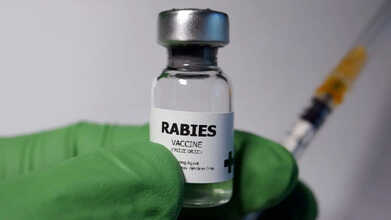- Health Conditions A-Z
- Health & Wellness
- Nutrition
- Fitness
- Health News
- Ayurveda
- Videos
- Medicine A-Z
- Parenting
- Web Stories
Screentime Is Leading To Insomnia, Researchers Say

Credit: Canva
Thousands of people struggle to sleep across the world. A survey of 45,202 young adults in Norway has discovered that screen-scrolling in bed drives up your risk of insomnia by 59 per cent and cuts your sleep time by 24 minutes. Scientists have found another reason to put the phone down: a survey of 45,202 young adults in Norway has discovered that using a screen in bed drives up your risk of insomnia by 59% and cuts your sleep time by 24 minutes. However, social media was not found to be more disruptive than other screen activities.
"The type of screen activity does not appear to matter as much as the overall time spent using screens in bed,” said Dr Gunnhild Johnsen Hjetland of the Norwegian Institute of Public Health, lead author of the article in Frontiers in Psychiatry. “We found no significant differences between social media and other screen activities, suggesting that screen use itself is the key factor in sleep disruption — likely due to time displacement, where screen use delays sleep by taking up time that would otherwise be spent resting.”
Sleep is critical to our mental and physical health, but many of us don’t get enough. At the same time, an increasing number of people are accustomed to using screens in bed, which may be associated with poor sleep. Screen use is thought to impact sleep in four ways: notifications disturb sleep, screen time replaces sleeping time, screen activities keep you wakeful so you take longer to fall asleep, or light exposure delays circadian rhythms.
"Sleep problems are highly prevalent among students and have significant implications for mental health, academic performance, and overall well-being, but previous studies have primarily focused on adolescents,” said Hjetland. “Given the widespread use of screens in bed we aimed to explore the relationship between different screen activities and sleep patterns. We expected that social media use might be more strongly associated with poorer sleep, given its interactive nature and potential for emotional stimulation.”
The findings of this study suggest that it’s not just the content that keeps people awake but the overall duration of screen exposure before bedtime. When people spend prolonged hours scrolling through screens, they might not only be reducing their sleep window but also disrupting their sleep cycles. This can have a cascading effect on overall health, affecting mood, concentration, and even immunity.
Reducing screen time before bed could be a simple yet effective strategy to enhance sleep quality. Setting a digital curfew, using blue light filters, and engaging in relaxing bedtime routines like reading a book or practicing mindfulness can help counteract the negative impact of screens. Sleep experts also recommend creating a sleep-conducive environment by dimming the lights and avoiding stimulating activities at least an hour before bedtime.
With screen usage becoming a significant part of modern life, it’s essential to be mindful of how digital habits influence sleep patterns. The consequences of chronic sleep deprivation extend beyond feeling tired the next day — they can increase the risk of mental health issues, cardiovascular diseases, and metabolic disorders. By taking small steps to reduce screen time in bed, individuals can make significant improvements to their sleep health and overall well-being.
Rabies Deaths in India: Why People Still Die Despite Effective Vaccines

Credits: Canva
A 47-year-old autorickshaw driver from Royapettah, who had received a full course of vaccination after being bitten by a stray dog in July 2025, died of rabies at the Rajiv Gandhi Government General Hospital (RGGGH). He is the 22nd person to succumb to the disease in Tamil Nadu this year.
His death has left experts asking a difficult question, if protocols were followed, why are people still dying? Public health specialists suggest this may not just be a failure of administration, but a sign that India’s long-standing rabies protocol itself needs re-examination.
What Is Rabies?
Rabies is one of the deadliest yet most preventable viral infections known to humanity. The World Health Organization describes it as a vaccine-preventable zoonotic disease that attacks the central nervous system. In nearly 99% of human cases, the virus is transmitted by dogs.“Rabies infects mammals, including dogs, cats, livestock and wildlife. It spreads to people through saliva, usually by bites, scratches, or direct contact with mucous membranes such as the eyes, mouth, or open wounds. Once symptoms appear, rabies is virtually 100% fatal,” explains Dr. Surrinder Kumar, MBBS, General Physician.
ALSO READ: Bird Flu In US: Are Cats Spreading A Deadly Disease?
Why Rabies Deaths Still Happen in India?
Despite the availability of effective vaccines, India continues to record thousands of rabies deaths every year. Dr. Surrinder says the problem is not medical science but lack of awareness and timely action. “Rabies remains endemic in India. Vaccines and immunoglobulins work, but the virus attacks the central nervous system and once symptoms begin, it is almost always fatal. The real challenges are late treatment, poor awareness, and preventive gaps.”For those unversed, Rabies immunoglobulin is a medication made up of antibodies against the rabies virus. It is used to prevent rabies following exposure.
According to Dr Surrinder, the main reasons are:
- Delayed or No Medical Attention: Many victims dismiss dog bites as minor and fail to seek immediate treatment.
- Lack of Awareness: In rural and semi-urban areas, people often don’t know the importance of post-exposure vaccination.
- Reliance on Home Remedies: Turmeric, lime, oils, and other traditional remedies are still used, offering no protection.
- Incomplete Vaccination: Even if treatment begins, many patients drop out midway, making it ineffective.
- Limited Access to Rabies Immunoglobulin (RIG): For severe bites, RIG is essential along with vaccines, but its high cost and patchy availability block timely use.
The Ground Reality of Rabies Treatment
Dr Shaswath Kumar G. S., a Bengaluru-based veterinarian, explains that anyone bitten by a stray dog without a known vaccination history must undergo the full course of rabies shots, along with immunoglobulin injected directly at the bite site. Before this injection is given, patients are required to undergo an allergy test, which often causes hesitation. He also points out that it may not always be free in government hospitals. The procedure itself is painful since the immunoglobulin is delivered directly into the wound.ALSO READ: Why 1 In 6 U.S. Parents Are Rejecting Vaccine Recommendations
Alongside immunoglobulin, at least five separate rabies vaccine doses are necessary. These, Dr. Shaswath says, are not without side effects, as “every time people take the vaccine, they get fever.” While cities are able to conduct mass vaccination campaigns, rural areas face significant challenges in this regard.
He further stresses that rabies is not confined to dog bites alone. The virus can also spread from other animals, and in rare cases even from humans, if infected saliva comes in contact with open wounds or mucous membranes. “A bite isn’t always necessary,” he warns.
Dr. Ranjeet Singh, Professor and Head of General Medicine at NIIMS Medical College and Hospital, echoes the same concerns. He emphasises that rabies deaths in India do not reflect a failure of the vaccine itself. Instead, the main reasons are late treatment, lack of awareness, incomplete vaccination, shortage of immunoglobulin, and limited access in rural areas.
Is India’s Rabies Vaccination System Flawed?
Experts stress that it would be wrong to doubt the vaccine itself. Doing so, they warn, could undermine public trust. “We have a robust programme. The National Action Plan for Rabies Elimination by 2030 (NAPRE) is already in place, and the vaccine’s efficacy is very strong,” doctors underline.India follows the WHO-approved five-dose rabies vaccine protocol, with immunoglobulin recommended for severe (Category III) bites. But the bigger question, they say, is whether the protocol assumes ideal conditions, which is immediate wound washing, uninterrupted cold chain storage, and trained professionals administering injections at the wound site. In reality, these conditions are not always met.
Common Mistakes After a Dog Bite Which Can Lead To Rabies
Dr. Ranjeet Singh highlights errors that often cost lives:- Not washing the wound immediately: The first step after a bite is washing with soap and running water for at least 15 minutes. Most skip it.
- Covering the wound too soon: Tying cloth or applying bandages traps the virus inside.
- Applying irritants: Substances like chili, lime, or ash worsen the wound and delay treatment.
- Ignoring minor bites or scratches: Even tiny wounds can transmit rabies if saliva enters.
- Stopping the vaccine midway: Completing the full course is essential; partial doses give no real protection.
To end rabies deaths in India, awareness must go hand in hand with medical access. Every bite, no matter how small, needs immediate action: wash, vaccinate, and if severe, take immunoglobulin.
“Rabies is 100% preventable but 100% fatal if ignored. No bite should ever be taken lightly. The key is simple, wash, vaccinate, and complete the course,” concludes Dr. Surrinder Kumar.
Do This 1 Thing Before You Pop A Pill For Your Migraine, According To Pharmacist

(Credit- Canva)
Sometimes a simple headache can derail your entire day. It slows down your work, causes you issues etc. When that happens, the easiest way to get rid of it is by taking medicine. However, did you know, you may be able to avoid taking the medicine by doing a simple check before?
Sometimes, the cause isn't a lack of medicine—it's a lack of hydration. Dehydration is a very common cause of headaches, and it's often overlooked. In a post, Suzanne Soliman, a US board certified pharmacist, explained that your headache may be a simple issue, that may not need medicine. Before you grab a pain reliever, try this simple trick: Drink a full glass of water with a small pinch of salt. The salt helps your body absorb the water better.
But how does salt water help you get rid of headaches? Is there medical backing to this or is it a placebo trick that helps some people?
Can Salt Water Treat a Migraine?
For some people, drinking salt water can help relieve a migraine, but it depends on the cause. Here are a couple of reasons why it might work:
You're dehydrated
If you've been sweating a lot, you lose both water and salt. Rehydrating with a glass of water and a pinch of salt can restore your body's balance and ease the headache.
You're on a low-salt diet
Several studies, like a 2021 study published in the Medical Science journal, suggest that if your body is used to a high-salt diet (like the average American diet), suddenly reducing your sodium intake can trigger a "withdrawal" headache. In this case, eating or drinking something salty might help.
However, the evidence isn't clear, and drinking too much salt water can make you feel sick. If you want to try this, only add a tiny pinch of salt to a full glass of water. A better way to get more salt might be through salty snacks or a sports drink with electrolytes.,
Can Eating Salt Prevent or Worsen a Migraine?
There's a complex link between salt and migraines. Some people who eat a lot of salt regularly report fewer migraine symptoms, possibly because their bodies are used to a high-sodium diet.
According to the 2021 study, the relief people feel when they eat salty foods during a migraine isn't a cure, but rather a temporary relief from withdrawal symptoms. This might help explain why some studies have found that people who eat more salt tend to have fewer migraines—their bodies are simply getting the high amount of salt they're used to.
Can Too Much Salt Trigger Migraine?
On the other hand, consuming too much salt can also be a migraine trigger. Eating too much salt can increase your blood pressure, which is a known cause of headaches and migraines. Studies have shown that for some people, a high-salt diet can actually make a migraine episode last longer.
Also Read: Frank Grillo On Steroid Use: 'I’m Not Cheating At Anything Except Aging'
A 2023 study published in JAMA included 213 people with a median age of 61. The group was 65% female and 64% Black. Each person followed three different diets: their usual diet, a high-salt diet, and a low-salt diet.
If your headaches are related to high blood pressure, a low-salt diet may be more beneficial
Salt's effect on migraines is different for everyone. It might help if your headache is caused by dehydration or a sudden drop in sodium, but it could also trigger a migraine or make it worse if you have high blood pressure or are sensitive to salt. Always talk to your doctor to figure out what's best for you and your symptoms.
Salt's effect on migraines is different for everyone. It might help if your headache is caused by dehydration or a sudden drop in sodium, but it could also trigger a migraine or make it worse if you have high blood pressure or are sensitive to salt. Always talk to your doctor to figure out what's best for you and your symptoms.
Frank Grillo On Steroid Use: 'I’m Not Cheating At Anything Except Aging'

(Credit- Frank Grillo Instagram)
Frank Grillo, the 60-year-old actor known for his roles in superhero films like Superman Peacemaker, recently opened up about how he gets in shape for the big screen. In a recent interview on the Men’s Health “Strong Talk” podcast, he candidly discussed his use of steroids, revealing that many actors use similar methods to prepare for roles.
Grillo spoke on his use of the steroid medication, and gave his view on its criticism. As a part of his Testosterone Replacement Therapy treatment, which helps improve symptoms of low testosterone, he took the medication, and it helped him deal with many age-related health issues.
Why Does Frank Grillo Use Steroids?
Grillo shared that about six years ago, he found out his natural testosterone levels were low. To fix this, he started using testosterone replacement therapy. He says this treatment has helped him in many ways, like improving his sleep, speeding up his recovery after workouts, and making him feel happier in general. Grillo doesn't hide his use of steroids.
Also Read: Do This 1 Thing Before You Pop A Pill For Your Headache According To Pharmacist
He pushes back against people who call it “cheating,” arguing that as an actor, he isn’t competing in a sport like football or wrestling. Instead, he’s simply trying to look the part for a movie role and, in his words, is "not cheating at anything except aging." He also points out that when actors are hired for a superhero movie, there’s an expectation to look a certain way, and sometimes that means using medications like Anavar, a steroid that acts like testosterone.
How Do You Build ‘Superhero’ Physiques?
Grillo claims that what he's doing is not uncommon in Hollywood. He believes that many other actors also use steroids to quickly achieve dramatic body transformations for their roles. He mentioned that drugs like Anavar and Deca, which is another type of steroid, are now often prescribed by doctors, which means their use can be monitored by a medical professional.
Grillo was very clear that incredibly muscular bodies aren't natural. He explains that it's just not realistic for someone to look one way for most of the year and then suddenly gain 35 pounds of muscle. He says that while many actors might not want to talk about it, everyone in the industry knows exactly what’s going on.
What Is Anavar/ Oxandrolone?
According to US National Cancer Institute, Oxandrolone is a man-made drug that's very similar to testosterone, a natural hormone in our bodies. It works by attaching to and activating certain receptors, which are like tiny switches in our cells. Because of this, oxandrolone is used for several reasons, including:
Testosterone replacement therapy: To help men who have low testosterone levels.
HIV-wasting syndrome: To help people with HIV who are losing a lot of weight and muscle.
Other conditions: To help the body hold onto more nitrogen (which is key for building muscle) and to increase lean muscle mass.
How Does Aging Effect Testosterone For Men?
According to Hospital for Special Surgery (HSS), as men get older, it's common for them to experience a natural decline in both testosterone and muscle mass. While this is a normal part of aging, there are ways to fight back against it.
Testosterone is a crucial hormone for men. It helps build muscle by creating proteins, which in turn increases muscle strength. Starting around age 40, a man's testosterone levels gradually drop by about 1-2% each year. This decline can lead to symptoms like fatigue, hair loss, and depression, but many men don't realize what's causing these changes because testosterone levels aren't always checked during a routine doctor's visit.
© 2024 Bennett, Coleman & Company Limited

